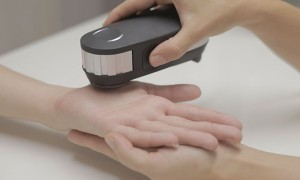
What is Oligoscan testing?
It is an innovative device that uses light to measure the intracellular content of important minerals and toxic metals. It can provide answers to why one is lacking energy, not responding to supplements or when other tests fail to provide solutions.
How is it performed?
The hand-held device, called a spectrophotometer. Is briefly held over 4 points on your palm. It records the wavelengths of minerals and metals in the cells of your tissues. This information is transmitted to a web application in the cloud, where it is processed and analysed. Within a few seconds the results appear on the computer, to be interpreted. With this valuable information, a treatment plan including nutrition, lifestyle and supplements is devised.
What makes spectrophotometric testing so innovative and exciting?
It is the first time we have a tool available to measure the intracellular concentration of important minerals and toxic metals. These measures are not readily available through conventional blood and urine testing. The cost is a fraction of what nearest equivalent tests would cost.
How does it work?
Every substance in nature emits or absorbs a particular wavelength of light. The wavelengths emitted from minerals and metals in the skin cells of the hand are recorded and analysed in conjunction with data such as weight, height, age and blood group.
The science behind it
Spectrophotometry used by OligoScan is an optical measure of the composition of the epithelial (skin) cells. This allows one to determine the tissue bioavailability of minerals and trace elements, but also the presence of toxic metals in the body.
It is a quantitative analytical method, which consists of measuring the absorbance or the optical density of a chemical substance. The basic principle is that every chemical compound absorbs, emits or reflects light (electromagnetic radiation) over a certain range of wavelength. The more the sample is concentrated, the more it absorbs the light within the limits of proportionality expressed in the Beer-Lambert law.
Optical methods are used in many domains: chemistry, pharmacy, environment, food-processing industry, biology, medical /clinical, material/chemical engineering, clinical applications and many others. In the clinical applications, optical methods are used to examine blood or tissues for clinical diagnosis.
The energy absorption of minerals is analysed by spectrophotometry:
• Atomic absorption of minerals is between 180 and 1000 nanometers.
• As an example, here are the different wavelengths of some minerals: Ca: 422,7 nm; Mg: 285,2 nm; Mn: 279,5 nm; K: 766,5 nm; Na: 589,0 nm; Fe: 248,0 nm; Cu: 324,7 nm; Zn: 213,9 nm.
• The optical reading of the absorbed light by the spectrophotometer produces a numeric result.
• These numbers are processed in algorithms and give a quantification of minerals (as biomarkers) in the tissue.
• These quantitative numbers are reflective of the concentration of minerals in the tissue of the patient.
• These numbers do not relate in any way to the numbers that are traditionally used for measurements of blood minerals.
• The results of the Oligoscan correlate to the physiology of the person.
Validation
The Oligoscan has a CE Mark (Class IIa medical device) registration approving the quality of its technology. Clinical studies have been performed and others are in progress. The findings correlate extremely well with the clinical symptoms of the patient.
Who can be tested?
Everyone can be tested, except children under the age of 12 or under 30kg weight. Pregnant women can be tested.
How it differs from other measurements
Oligoscan enables one to precisely measure the bioavailability of minerals, trace elements and toxic metals in the cells of the body in real time. Measurements done on body fluids are more unstable and often less reliable. Urine testing shows what the body excretes. Hair analysis shows what happened in the body a few weeks before. Blood tests show what substances are circulating. Urine challenge tests for toxic metals reveal what metals are in the extracellular compartment, whereas Oligoscan reveals what is intracellular. Thus the Oligoscan does not replace the need for other forms of testing. The different measurements do not correlate as they are measuring different things. All measurements provide important dimensions of understanding and independent information related to minerals and metabolism, and should be part of a global understanding of a patient.
At follow-up, the effects of lifestyle and dietary changes and supplementation can be measured again. The aims are to regain homeostatic balance of the minerals and eliminate the toxic metals.
In summary
By analysing the content of tissues, Oligoscan shows the metabolism and the homeostasis within the cells, as well as the mineral reserves available. It reveals the concentration of toxic metals present, which act as significant obstacles to optimal health. This amounts to a valuable reflection of the physiology of the patient, which is difficult to obtain by other means.
Oligoscan testing is now available at Greenhouse Health. The cost for the first test is R750 [excluding cost of consultation] and follow-up tests cost R600.
Visit the Oligoscan website here.








